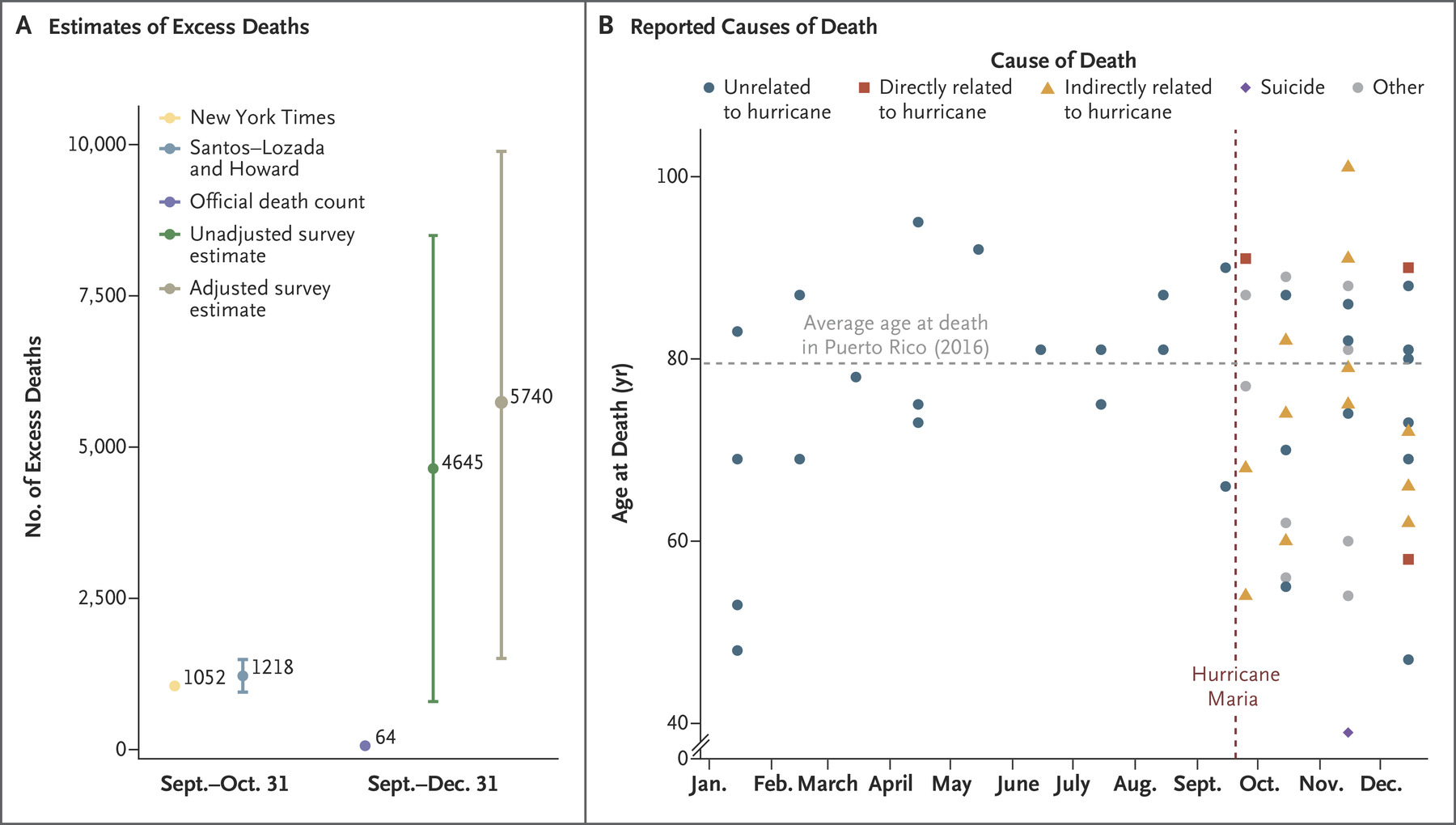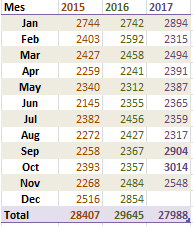A new study from Harvard researchers published Tuesday in The New England Journal of Medicine said that the death count in Puerto Rico due to Hurricane María is more than 70 times the official government number of 64 deaths, which would result in a death count of over 4,600 lives.
The study, based on a survey conducted by Harvard T.H. Chan School of Public Health, concluded that Puerto Rico’s mortality rate between September 20 through December 31, 2017 was 14.3 deaths per 1,000 persons. (All the data sets are here.)
“This rate yielded a total of 4,645 excess deaths during this period… equivalent to a 62% increase in the mortality rate as compared with the same period in 2016. However, this number is likely to be an underestimate because of survivor bias. The mortality rate remained high through the end of December 2017, and one third of the deaths were attributed to delayed or interrupted health care. Hurricane-related migration was substantial,” the study said.
(The study did conclude that there is a 95 percent probability that the death count was between about 800 and 8,500 people, but also felt that the the final estimate will be around 5,000 lost lives.)
According to the New England Journal of Medicine report, the researchers randomly surveyed 3,299 households across Puerto Rico “to produce an independent estimate of all-cause mortality after the hurricane.”
“Respondents were asked about displacement, infrastructure loss, and causes of death,” the study noted. “We calculated excess deaths by comparing our estimated post-hurricane mortality rate with official rates for the same period in 2016.”
In addition, the study also stated: “Because we could not survey single-person households in which a death had occurred,… we adjusted our estimate by using the 2016 mortality rate for single-person households. Our adjustment for this survivor bias and household-size distribution resulted in a post-hurricane estimate of 5,740 excess deaths.”
The study also included the following figure of how researchers estimated the excess deaths:


Panel A shows a comparison of estimates of excess deaths from official reports, press (New York Times)8and academic (Santos–Lozada and Howard)9 reports, and from our survey. Panel B shows deaths according to the month of death and the age at death as reported in our survey, categorized according to the cause of death reported by the household member. Two persons who died of similar causes at the same age are represented by dots that are superimposed in December; thus, the 37 points shown represent 38 deaths after the hurricane.
The Harvard study comes days after researchers at George Washington University said that their own study commissioned by the government of Puerto Rico about the death count will be released later in the summer.
Requests to the government of Puerto Rico for comment about the Harvard study have yet to be answered at the time of this story being published.
A spokesperson for GW told Latino Rebels Tuesday morning that “no one from the GW team is available to comment on the new study.”
In November, Puerto Rico’s Center for Investigative Journalism published its first analysis of uncounted deaths, and on December 7, using public health data, it reported an excess of 1,000 deaths, when compared to the same time period in 2016. On December 8, The New York Times published its own analysis. A November 21 study by Alexis Santos, the Director of Applied Demography at Penn State, concluded that the Hurricane María death count could be 10 times higher than then official government count.
As of January 4 (the last update Latino USA received), the government of Puerto Rico said there were 1,194 more deaths in September and October 2017 combined when compared to 2016.
September 2017 and October 2017 were two months with the most deaths in Puerto Rico for the last three years.


UPDATE, May 29, 11:45amET: The government of Puerto Rico issued a statement about the study attributed to Carlos R. Mercader, executive director of the Puerto Rico Federal Affairs Administration.
The Government of Puerto Rico welcomes the newly released Harvard University survey and we look forward to analyzing it. As the world knows, the magnitude of this tragic disaster caused by Hurricane Maria resulted in many fatalities. We have always expected the number to be higher than what was previously reported. That is why we commissioned The George Washington University (GWU) to carry out a thorough study on the number of fatalities caused by Hurricane Maria which will be released soon. Both studies will help us better prepare for future natural disasters and prevent lives from being lost.
BuzzFeed News also reported the following about what Puerto Rico governor Ricardo Rosselló told reporters Tuesday during press conference that was related to hurricane preparedness:
“There really is no logical explanation for us wanting to [suppress] the numbers. We want the real number to come out,” he said. “We had a protocol that really was sub-par and we recognize it and now really towards the future we want to make sure that it is effective.”
He said his administration has “always said” that the death toll number was going to rise.
“That number was the result of the process that we had in place. And that’s why we have invited GWU to do an independent study,” he said.
UPDATE, May 30, 7:00pmET A day after the Harvard study was publish, the GW research team issued a statement. This is the full statement:
Milken Institute School of Public Health Statement on New Study to Estimate Excess Mortality in Puerto Rico Tied to Hurricane Maria
WASHINGTON, DC (May 30, 2018)— The Milken Institute School of Public Health at the George Washington University (Milken Institute SPH) issued the following statement about Harvard University’s study published Tuesday in the New England Journal of Medicine on mortality in Puerto Rico tied to Hurricane Maria:
The study led by Harvard researchers on the deaths tied to Hurricane Maria is a welcome addition to the scientific literature on the impact of the hurricane in Puerto Rico. The Harvard study used methods that are commonly used following disasters where there are few or no official records of death.
The study is based on estimates from household surveys and not on actual records of death. In that way, the Harvard study is fundamentally different from the Milken Institute SPH study commissioned by the Government of Puerto Rico.
The household survey method used by Harvard researchers in Puerto Rico gives a wide estimate of the deaths tied to Hurricane Maria. Given the design of the household survey in the reality of a difficult post-disaster environment, it is appropriate that the researchers reported the deaths with wide intervals that convey the range of uncertainty. The estimate of 4600 excess deaths reported in the popular press falls within a range of uncertainty, and that means that the number could be lower or higher than that (referred to by scientists as a 95 percent confidence interval). The study further provides insight into the circumstances surrounding deaths and the emergency context in which people were living —both will inform future research and interventions.
The epidemiological study being conducted by researchers at Milken Institute SPH will use actual data about deaths –death certificate and other mortality data from September 2017 to the end of February 2018– in order to estimate the excess deaths related to Hurricane Maria. Estimating deaths using such mortality data is a time-consuming and difficult task, one that has rarely been done after a disaster of this magnitude. In the context of the health care and death registration systems of Puerto Rico, it is a more accurate way to assess mortality. In addition, the study will evaluate the death certification process to understand how this process was implemented under normal conditions and how the process was affected in the aftermath of the hurricane. Finally, the Milken Institute SPH team is also assessing the Puerto Rican government’s communications with the public regarding the storm.
The Milken Institute SPH study is expected to provide a narrower range of uncertainty around the estimated excess deaths tied to Hurricane Maria. It will also offer recommendations that will help the government of Puerto Rico prepare for future natural disasters.
The Milken Institute SPH study was slated to be finished by the end of May; however, collection of the data has taken longer than expected. A final report for the Phase I of the two-part study is expected out this summer.
***
Julio Ricardo Varela is founder and publisher of Latino Rebels, part of Futuro Media. He tweets from @julito77.



[…] were mad at the governor for disrespecting the estimated 4,645 people who died after the hurricane. They are tired of the corruption, the austerity, the school closings, […]
[…] adequate or timely assistance, resulting in hunger, homelessness, and the deaths of at least 4,645 people. In addition, María’s aftermath brought about the migration of over 120,000 […]
[…] ayuda adecuada y puntual. Esto tuvo como consecuencia el hambre, el desamparo y las muertes de al menos 4,645 personas. María también desató la emigración de al menos120,000 residentes (un 4% de la población), a […]